It’s no secret that knitting requires practice, time, and, yes, a little patience.
So, while taking a few knitting classes, buying a few knitting craft kits, and learning new projects help to evolve in the craft, sometimes all we really want is a little knitting fun without all the hard work.
That’s where knitting machines come in!
Knitting machines are a great way to enjoy all the yarn joy you desire while cutting down on time and intricate processes — you can make projects up to 20 times quicker with one of these babies!
We’ve put this in-depth beginner’s guide together to help you choose the best knitting machines, including guidelines on how they work, which to buy, and lots of FAQs to make sure you make the perfect pick.
In a rush? Grab one of the quick picks below. They won’t do you wrong.
Affiliate Disclosure: Articles on Tiny Workshops may contain affiliate links.
Addi is the king of knitting machines, and its largest 46-needle machine is the best option on the market, although it is pricey.
If you don’t mind a cheaper build quality, the Sentro knitting machine can work just as well as models that cost twice as much.
This is the best flat bed knitting machine still on the market, and it’s great for professionals incorporating complex patterns.
The perfect gift for creative teens and beginner adults looking for new creative hobbies on a budget.
Guide to knitting machines
What are knitting machines?
Knitting machines for home use are, first and foremost, a delight! These devices can be circular or flat and are used to knit garments and items of all types in flat or tubular forms with the help of a crank or carriage.
And don’t worry, knitting purists, this is not cheating!
While knitting machines call for different processes and techniques (more on this below), the main goal of using these devices is to increase speed while at work. They can also be a boon for crafters with arthritis or other issues related to manual dexterity.
Indeed, a knitting machine doesn’t always allow you to achieve the intricate, detailed finishes and stitches you get with traditional knitting. However, it gets you creating all kinds of pieces like blankets, socks, beanies, and more in a short period.
Despite your level of expertise and skill with traditional knitting, the beauty of knitting machines is that they provide a different perspective and approach to the craft. The truth is that machine knitting has very little to do with handheld knitting!
I think not having prior knitting know-how will actually work to your advantage since it will prevent you from constantly comparing approaches and feeling conflicted while following the steps in machine knitting.
Types of knitting machines: Circular vs. flat bed
There are two types of knitting machines for home use: circular and flat bed, and although they can achieve similar results, device design is completely different.
Here’s a quick comparison of circular vs flat bed knitting machines to help you decide which one is right for you.
Circular knitting machines
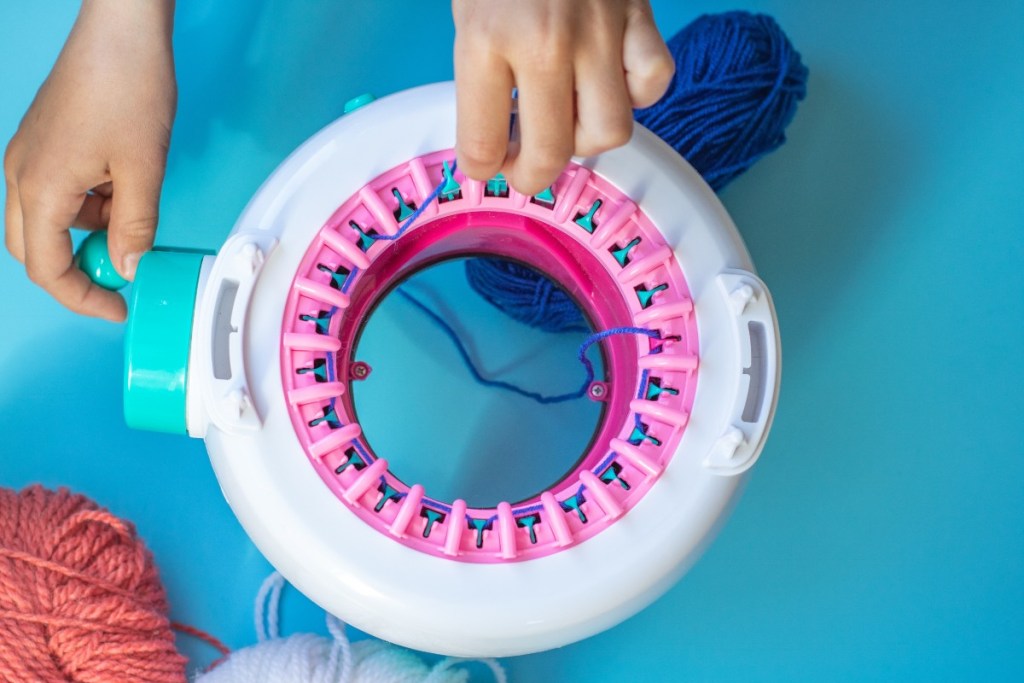
Circular knitting machines are fixed-gauge machines and are the most popular because they’re easier to learn. These are primarily used to knit tubular pieces without seams — ideal if you’re looking for a sock knitting machine!
Note that you can also knit flat panels on these devices, but you’ll have to seam them together separately.
Circular knitting machines weave the yarn around the rim of the device, which is also known as the needle bar. The needle bar is made up of several plastic pins (usually ranging from 22-48 needles in household models) that hold the yarn and interlock it into a knitted form as you turn the crank.
Flat bed knitting machines:
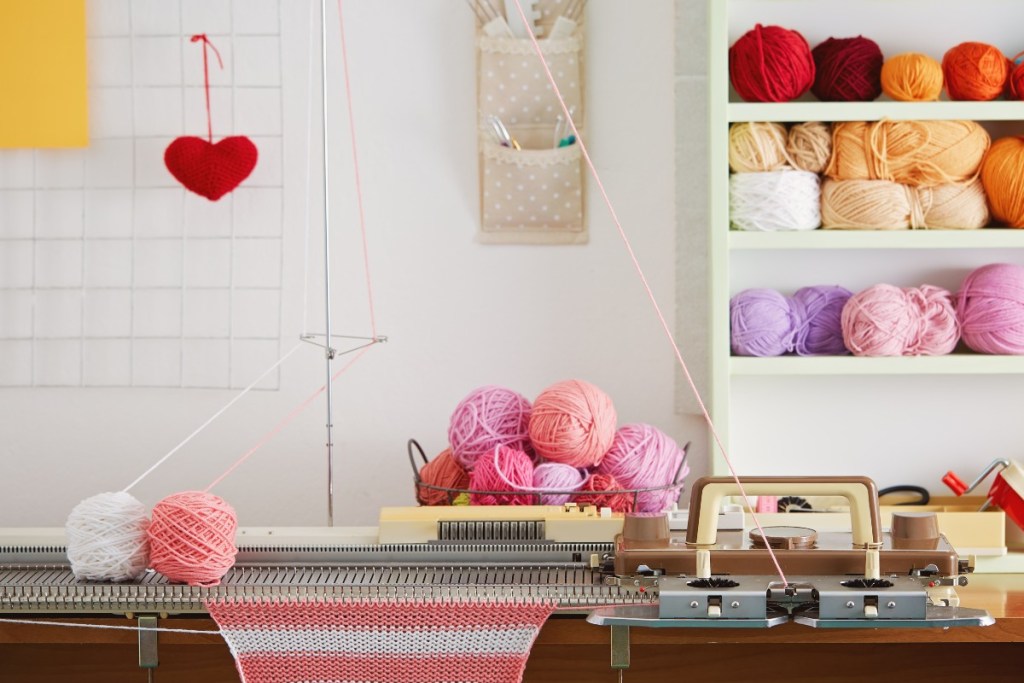
Unlike circular knitting machines, flat bed knitting machines for home use are usually mid-gauge devices and are elongated, larger structures used to create flat knitted pieces. That said, you’ll be doing more manual seaming.
Latch needles are arranged on a flat steel structure called a bed. These can get very complex, but flat bed knitting machines for home use are less elaborate and come with easy-to-follow manuals to help you set up.
As you slide your carriage (the tool that glides across the needles to create stitches), the latch needles will move forward; they will grasp a loop and take it behind the latch.
The yarn then goes through the hook of the needle and forms a stitch as it is pulled back. Therefore, a row will be knitted each time the knit carriage slides over the entire bed of needles.
What to know before buying a knitting machine
As you start looking into knitting machines, whether circular or flat bed, there are a few pros and cons to consider before making your pick.
I’ve listed the most significant pros and cons below:
Pros:
- Knitting machines speed up work, whether cranked manually or with an extension/power tool
- Create more items at a quicker rate
- Can knit patterns with multiple colors
- Easy to manage tension
- Quick to remove rows if you’ve made a mistake
- Produce neat, uniform stitches
- Tuck stitches, plating, and knit weaving are easier to master
- Can knit both tube-shaped and flat panels
- Devices available for all budgets
Cons:
- Steep learning curve (mostly flat bed knitting machines)
- Projects may not look as organic as handmade works
- Some stitches, such as garter stitches, are harder to achieve
- Every knitting machine supports a limited range of yarn weights
- The needle pitch and gauge of your device can limit your project
- You may need to seam flat pieces together depending on your project
- Some devices may be loud
- Requires somewhat frequent maintenance and cleaning
Best knitting machines
Below, we’ve listed our top picks for the best knitting machines based on popularity, quality, price, and skill level.
Check out our brief glossary at the end of the article if you need some guidance on knitting machine terminology to get started!
Looking for smaller machines for socks? Check out our favorite sock knitting machines here!
Best circular knitting machine: Addi Express King Size 46 Needle Knitting Machine
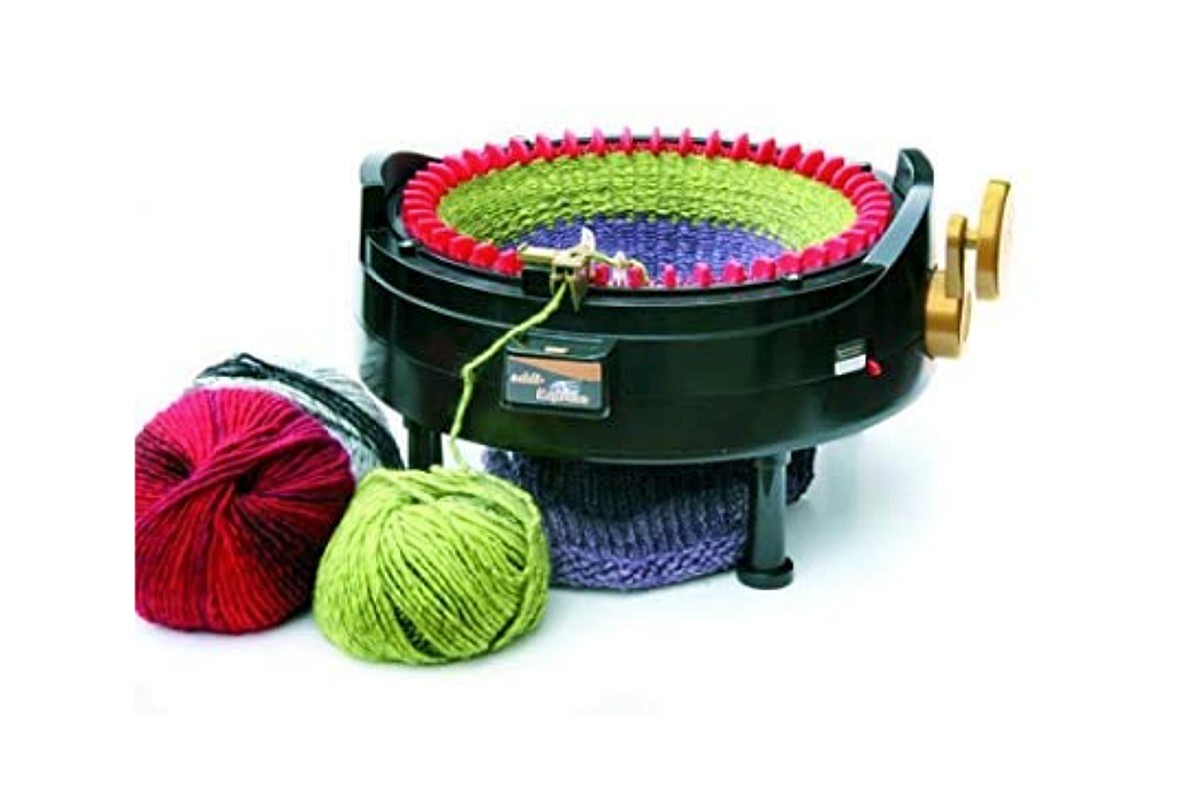
Pros:
- The highest-quality machine on the market
- Versatile yarn weight options
- Cranks smoothly with minimal snags
Cons:
- Pricey
- Somewhat loud
If you know anything about knitting machines, chances are you’ve heard of the one and only Addi Express King Size knitting machine.
Addi is a prestigious German company with a longstanding legacy in the needlecraft supply world and takes the cake for producing the best knitting machines on the market. And this Addi model is no exception!
Featuring 46 needles, this sturdy circular knitting machine is easily our top pick. It’s compatible with all skill sets and for making all kinds of items, whether circular or flat-panel knitting projects: ~13 inches (~35cm) in diameter for circular knitting and ~17 inches (~45cm) wide for flat knitting.
In addition, it’s suitable for yarn sizes 4-8, offering a flexible range of yarn weights to work with. I can tell you that that’s a broader range than what most knitting machines on the market can achieve!
The set includes five replacement pins, metal clamps for table mounting, a needle holder, base feet, and an integrated row counter. Its sturdy, solid plastic structure is also prime quality, unlike the more toy-like materials found in most hobby knitting machines.
The company also has an ever-growing commitment to resource-friendly production, which is a plus if you actively seek environmentally conscious manufacturing. It’s about time we all start taking this factor into consideration!
Like other knitting machines, you’ll have to devote some time to the Addi to fully master all of its features. Nevertheless, you’ll receive an in-depth instruction manual and can find many tutorials in multiple languages on the brand’s YouTube channel for additional support!
You can find the Addi Express King Size machine on Amazon for way over $100, which tends to be the standard pricing for this machine. Cheaper Addi models include the 22-needle sock knitting machine (also available on Amazon) and the coveted AddiEgg, ideal for macrame cord-making and customizing projects.
The significant advantage of the Addi comes down to one word: quality. It’s built to last, can support a wide range of yarn weights, is compatible with crank adapters (can be plugged into electric power tools for extra speed), includes sturdy table clamps, and allows you to create tubular and flat knitting projects.
If I had to point out a downside, it would be that this device tends to be a little louder than other models. However, if you ask me, this is a tiny detail considering this knitting machine’s 5-star quality and features.
Best value for money: Sentro Knitting Machine 48 Needle Smart Loom

Pros:
- Very affordable
- Includes all tools and materials
- Widely available
Cons:
- Middling quality
- Many knockoff products online
- Suction feet prone to slipping
The 48-needle Sentro is undoubtedly the runner-up for the best knitting machine, high in demand for its affordability and practicality.
At a little over $60, this device is ideal for non-knitters and complete beginners and an excellent option if you’re looking for an authentic circular knitting experience without breaking the bank.
While less high in quality than the Addi model above, the Sentro absolutely gets the job done — it’s just more limited in features.
The lightweight set includes plastic crochet needles for casting on/off, an integrated row counter, a crank, a thread holder, tension, four skeins of yarn (basic quality), and a screwdriver.
Set up is easy: all you have to do is build in the legs and put in the suction cups to ensure steadiness while cranking — this is not as effective as table clamps but works fine. Note that this device works best for tubular knitting but also has a flat-panel switch.
This is a standard gauge machine, so weight yarn is more limited here; ideally, you should work with no more than 4 weight yarn. Therefore, I recommend a more heavy-duty model if you want to work with bulky yarn.
Some crafters try using heavier yarn on the Sentro machine, but in my opinion, it’s not a great idea. These machines aren’t built to handle thick yarn, and doing so will cause your machine to slow down and eventually jam. The moral of the story? Go for the Addi machine if you want to work with heavier yarn.
When purchasing a Sentro, there’s an important topic to touch on. Although this machine is an excellent choice, finding the right seller for purchase can get tricky.
Many sellers are advertising this product on Amazon for different prices (it’s hard to find anywhere else, really), which has led to customers receiving different versions of the same machine. This includes several sets branded “Santro,” “Miaoke,” “Awperex,” or even with no label at all, instead of “Sentro.”
So, does this mean that you could be paying for a knockoff?
Yes and no. While labeling may be different, and understandably, you want the brand you’ve paid for, most of these machines are manufactured in the same place and are essentially the same device.
To ensure you get an “official” Sentro, I suggest purchasing from this seller since it’s an authorized retailer working with producers to sell on Amazon. Buying directly from the Sentro store on Amazon should also guarantee you get the real deal.
Despite this conundrum, this machine is undoubtedly worth a shot if you’re a hobbyist trying knitting machines for the first time and aiming to stay on a budget. You can also try the Sentro 22-needle sock knitting machine if you’re interested in smaller projects.
Best flat bed knitting machine: Silver Reed LK150 Knitting Machine

Pros:
- Premium device
- Supports almost every yarn weight and type
- Includes everything you need
Cons:
- Expensive
- Not ideal for beginners
- Light, but quite large
Whether you’re ready to move on from a circular knitting machine or are looking to create more elaborate items, the flat bed Silver Reed knitting machine is definitely the product to go for.
This model is one of very few flat bed knitting machines for home use still being manufactured and has been distributed under famous brands such as Singer and KnitMaster. Metal-bed alternatives cost twice as much or more and can be nearly impossible to find online!
Despite its apparent complexity, this knitting machine is simple to set up. It does include a ton of supplies, though! A needle bed, claw weights, table clamps, a carriage with a stitch dial, tension mast items, cast-on combs, hand tools, oil, backup needles, and ravel cord are only a few of the many items included.
One of my favorite things about this set is that it includes everything you’ll need — including a comprehensive instruction manual. Another perk worth highlighting is that it’s ranked as a mid-gauge device and responds well to almost every yarn weight under the sun.
Although knitting with all types of bulky yarn isn’t advisable, the Silver Reed is compatible with all kinds of textures and yarn weights, such as sock yarn, fuzzy, natural fibers, blends, light worsted thread, and more.
Keep in mind that you will not be making tubular knitted pieces here; additional seaming will be needed in this case. But if that’s all you want to do, you should probably get one of the cheaper circular knitting machines above.
Although this knitting machine is ideal for larger, more complex projects (though not exclusively), some techniques, such as garter stitches, are more challenging to achieve and best done by hand. Therefore, you may need to take on some hand-stitching work during projects. It’s also one of the reasons why this model is a better buy for somewhat experienced knitters.
Because this is more of a high-end, complete set than your typical circular knitting machine, this product costs $400-500 and higher, depending on the seller. You can find a white-labeled model on Amazon and another on Etsy (although only shipped within the US and subject to back orders).
However, as an undoubtedly more versatile machine than the previous ones on the list, this is the purchase if you aim to experiment with a wider range of yarn weights to create more detailed, long-lasting knitted items. It’s pretty large, but the plastic bed is remarkably light and easy to store.
Best knitting machine for children: Mushroom House 32 Needles Knitting Machine
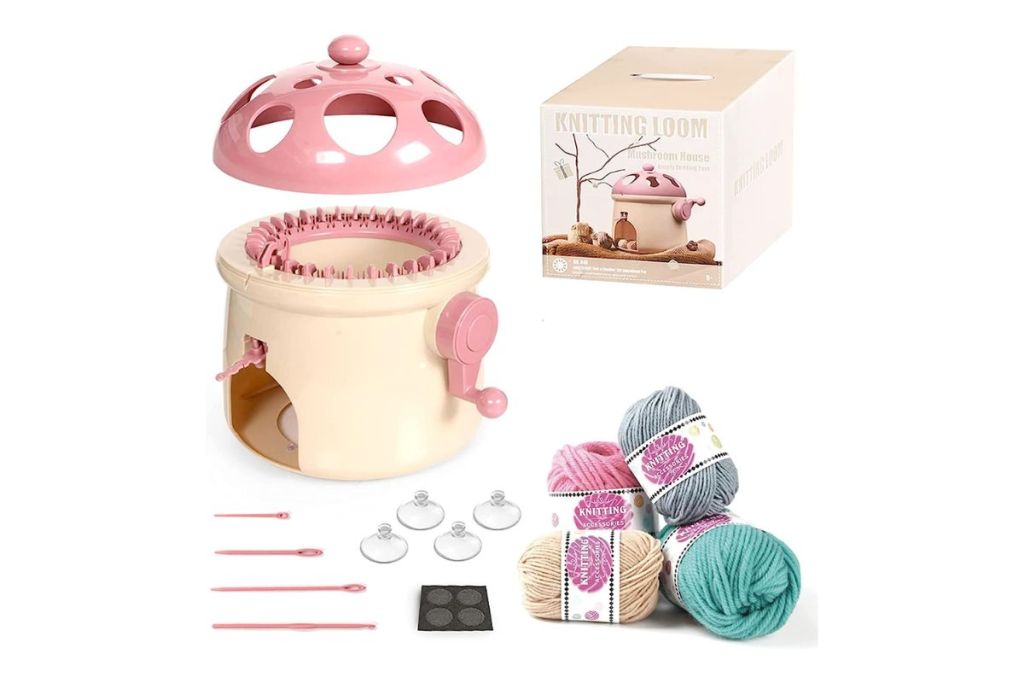
Pros:
- Kid-friendly but suitable for complete beginners of all ages
- Includes additional materials
- Works well for small projects
Cons:
- Doesn’t support heavier yarns
- Generic model
- Need to take it slow
This circular, toy-like knitting machine is, without a doubt, the surprise of the bunch.
While primarily marketed for children, this straightforward, easy-to-use product is an affordable alternative for crafters of all ages getting their feet wet in machine knitting. It’s a great pick for a gift or to keep kids entertained with creative, handmade projects.
Because it leans toward generic vibes, it’s only natural to feel hesitant about whether it’s worth buying. On the other hand, compared to similar options, such as popular knitting machines by Singer (which is also hard to find), this one really hits it out of the ballpark!
This machine has a total of 32 plastic needles and features a versatile tension guide, a crank, and the option to select between tube or flat panel knitting modes.
Because it’s not top of the line and not the largest in diameter, yarn weight should be light. Nevertheless, considering what you’re paying for, it’s a nice, complete set. Your pack will also contain additional materials and supplies to help you jumpstart your first knitting machine experience.
The most important thing to consider is that this model has a smaller needle gauge than most hobby models, so go with something more versatile if your goal is to delve into larger projects.
On the other hand, it makes for a perfect sock-knitting machine and an excellent device to create headbands, ear warmers, baby beanies, and even small-sized amigurumi!
However, one of the downsides of this model is that it doesn’t incorporate a row counter. If this interests you (trust me, it’s really handy!), you can purchase a very inexpensive digital row counter online.
This is a surprisingly effective little machine, whether for children or adult beginners wanting to explore the world of machine knitting from scratch. Just remember to have the right expectations, as this is a more basic, toy-like model.
Other knitting machine supplies and tools
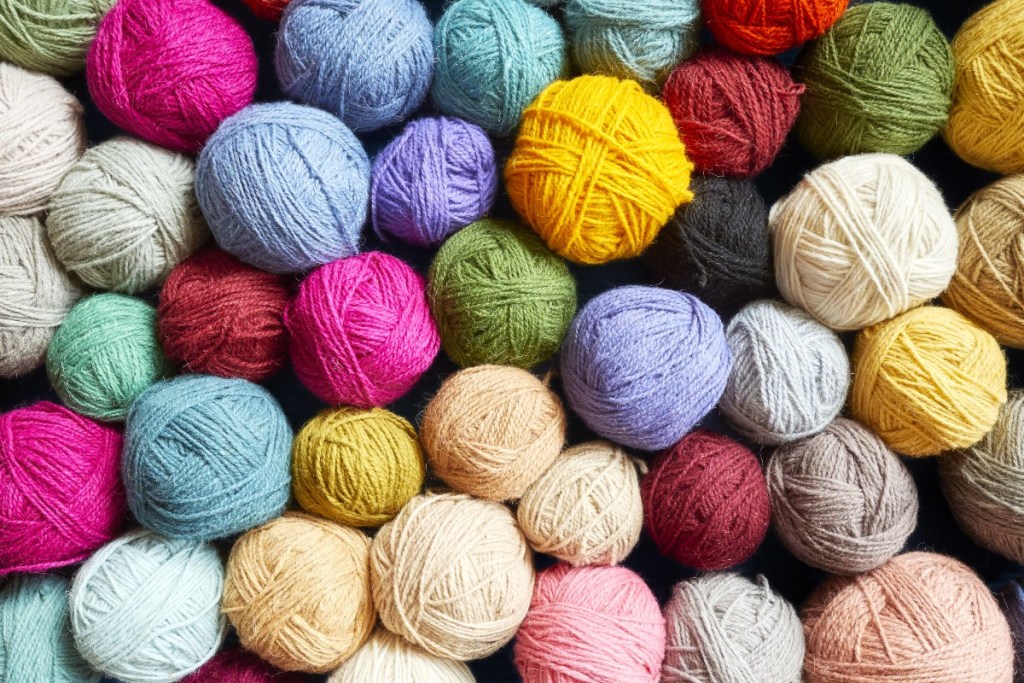
While on your knitting machine ventures, there are additional supplies and tools to consider adding to your craft station to create and support your projects.
Here are a couple to keep in mind!
Yarn winders
This tool conveniently winds up yarn into perfect cakes and skeins with little to zero effort. This will help you keep your workspace organized and allow you to craft more efficiently. You can check out our top picks for yarn winders here for guidance!
Yarn bowls
Although not essential, yarn bowls really do help keep skeins in place, preventing them from getting dirty, unraveled, and with just the right amount of tension to knit away. We have a few suggestions for our favorite yarn bowls here to get you started.
Yarn
This is obviously a must for machine knitting and should be selected with some level of criteria. Make sure to choose quality supplies if you’re aiming to make long-lasting pieces, and, more importantly, make sure they’re compatible with your machine’s gauge. Most circular knitting machines are fixed gauge devices that support 3-4 yarn weights.
Digital counter
While most hobby knitting machines incorporate a row counter, unfortunately, these tend to fail over time. An excellent backup and solution is purchasing a digital counter! There are many available like this one that are inexpensive and easy to order.
Knitting machine adapter/extension
Getting an adapter is a great way to speed up cranking (even more!) on a budget. You can clamp these pieces onto your crank and connect a power tool such as a drill to get the machine moving semi-automatically.
While this doesn’t guarantee you’ll be going as fast as Flash, it will give your arm and wrist some rest! Make sure you buy an adapter that’s compatible with your machine. This one, for example, is designed for Sentro models.
Crochet hooks
A few quality crochet hooks can do wonders for finishings and embellishments you may want to add when you cast off your knitting machine. If you’re not familiar with these tools and want to learn how to use them, we advise taking a few online crochet classes.
Yarn needles
Another item used to cast off that will be very helpful is bent-edge yarn needles. Although any form of yarn needle will work just fine, one with a bent tip will work the best, especially if you’re doing lots of projects and want to work more efficiently.
How to use a knitting machine
Knitting machines may look complex and hard to understand at first, but the secret is that they’re pretty straightforward once you get the hang of things.
And you will; all it takes is a little practice!
We highly recommend that you check out a few video tutorials when first starting out, but here’s how to use a knitting machine in brief:
How to use circular knitting machines
Before starting, you need to clear your row counter — this will tally how many rounds you’ve done, especially when creating patterns or changing yarn colors.
It’s crucial to get the first row done correctly. This establishes the foundation of your entire project.
You need to thread your yarn through a specific needle before any other, used as a starting and ending reference for each completed row. You’ll have to leave a few inches of thread hanging into the machine’s center and keep the remaining skein on the side.
A yarn bowl is an excellent accessory for this part of the process!
Next, you’ll need to manually weave the first round of string in front and behind all the needles in a zig-zag-like manner while gently winding the crank for movement.
As you slowly work through the first row, you’ll notice that the needles will lock and secure the yarn. Once you’ve completed your first round, you’ll repeat this process, only now threading in front of the needles.
After completing the second round, you can set the string of yarn through the holder and place it through the tensioner. Then, you can start cranking carefully for 3-4 more rounds without using your free hand for support.
When concluding these rows, you can increase speed, turn the crank quicker, and knit away!
How to use flat bed knitting machines
To start, you’ll need to thread your machine through a vertical tension mast connected to the center of the device, where you’ll also make adjustments for tension.
You’ll then attach a sinker plate to the carriage and thread the loose end of the yarn from the tension mast through it. You can use a fabric comb to adjust needle positions on the bed before knitting to create specific patterns.
Next, you’ll adjust the tension dial on the carriage (to regulate stitch size) and pull the carriage across the bed. Add weights on your first row to avoid pulling to ensure your stitches stay in place as you work further. You can also use a ravel cord to help you cast on more swiftly.
As you gently work through your first rounds, you can start gliding your carriage back and forth and knit more freely and quickly once you see a foundation forming.
Knitting machine terminology
Struggling with the names of knitting machine parts and techniques?
Here are all of the key terms you need to know!
- Bulky gauge: Refers to knitting machines with 9-10 mm needle pitch.
- Casting on/casting off: Process of starting and completing your project (setting up/removing from the machine) with handheld tools and techniques.
- Carriage: The part of a flat bed knitting machine used to glide across the needle bed to form stitches.
- Crank: The handle you turn for movement in a circular knitting machine.
- Fine gauge: Refers to knitting machines with a 3.6 mm or lower needle pitch.
- Gauge: This can refer to the number of stitches and rows per square inch/square cm. or the spacing between needles on a knitting machine. The closer the needles, the thinner the yarn the device can support.
- Knit and purl stitches: Two of the most fundamental knitting stitches. A knit stitch can be seen at the front of the fabric, whereas purl stitches are seen on the back. Therefore, the back of a purl stitch is a knit stitch, and vice versa.
- Needle: A metal piece with a hook and a latch that secures and knits yarn.
- Needle pitch: The distance between needles on a knitting machine.
- Row counter: A tally counter to keep track of the number of rows worked, stitch patterns, increasing/decreasing stitches, etc.
- Standard gauge: Refers to knitting machines with 5 mm or 4.5 mm needle pitch.
- Tension mast: This vertical structure guides yarn and manages yarn tension into the carriage when using a flat bed machine. A tension guide will also be seen on circular hobby knitting machines but is more simplified and limited.
- Stitch size dial: This mechanism is part of the carriage tool and defines the stitch sizes/width on flat bed machines. It’s also commonly referred to as a tension dial.
- Yarn weight: Refers to the thickness of different types of yarn. Your knitting machine will determine what types of yarn you can work with.
FAQS
Who invented the knitting machine?
The first knitting machine was invented in 1589 by Englishman William Lee, known as the stocking frame, a mechanical knitting device used in the textile industry. It was the first machine ever created to replicate the movement of handheld knitting.
Is using a knitting machine difficult?
While knitting machines are practical for speed and creating stitches with little effort, learning how to manage your device correctly and understand its functionalities may take some time.
That said, all you need is a little practice and patience. Fortunately, tons of online tutorials and fellow crafters provide loads of information to help you through your journey!
How much faster is it to work with a knitting machine?
The average time would be 10-20 times quicker than traditional knitting. This does, of course, also depend on your machine, yarn weight, and the size of your project. But there’s no doubt that you’ll be saving a significant amount of time with a machine.
Are flat bed knitting machines better than circular knitting machines?
They’re different in the sense that they are best for different purposes.
Flat bed machines allow for more elaborate projects and more stitching patterns. Since these devices also have more needles than circular knitting machines, you’ll be able to create larger flat panels in one go.
However, whether you work with a circular or flat bed device, flat panels will always have to be seamed separately.
Do you need to know how to knit to use a knitting machine?
No, you don’t need to be a knitter to use a knitting machine. Previous knitting experience may help you work better with the machine, especially if you’re familiar with the lingo and techniques.
However, knowing too much can also get in your way if you’re not open to adapting to a new knitting process. Mastering basic stitches can benefit you, especially when casting off your projects.
You can check out some of the best online knitting classes here if you want to learn the basics of the craft first!
Is buying a knitting machine worth the cost?
Knitting machines are great tools if you have never got into handheld knitting or don’t have the time to work on zillions of projects the traditional way.
Knitting machines can be quite affordable, but even high-end models aren’t excessively expensive. If you plan on using your machine frequently, no matter which one you choose, it’s definitely an investment worth making to save time.
What can be made with a knitting machine?
So many things! Scarves, wooly hats, sweaters, Afghans, skirts, blankets, socks, gloves, leg warmers, etc. With flat panels, you’ll even be able to make bags, pillow covers, amigurumi, cardigans, and more!
The 22-needle machine seems narrow — is it worth it?
Yes! Depending on your goal and the yarn you use, this machine can make everything from socks and children’s scarves (or thinner scarves for adults) to mittens, tube socks, beanies, and more.
Also, don’t forget that you can always use the flat panel mode to create larger items and seam them together piece by piece.
How do I know how many rows to make a hat, pair of socks, or scarf?
You can refer to measurement and pattern charts to have an idea of what this translates into with a knitting machine. You can refer to several online patterns when starting a project such as this one.
That’s all for this comprehensive buyer’s guide on the best knitting machines! Which machine or model will you be getting? Let everyone know in the comments below!

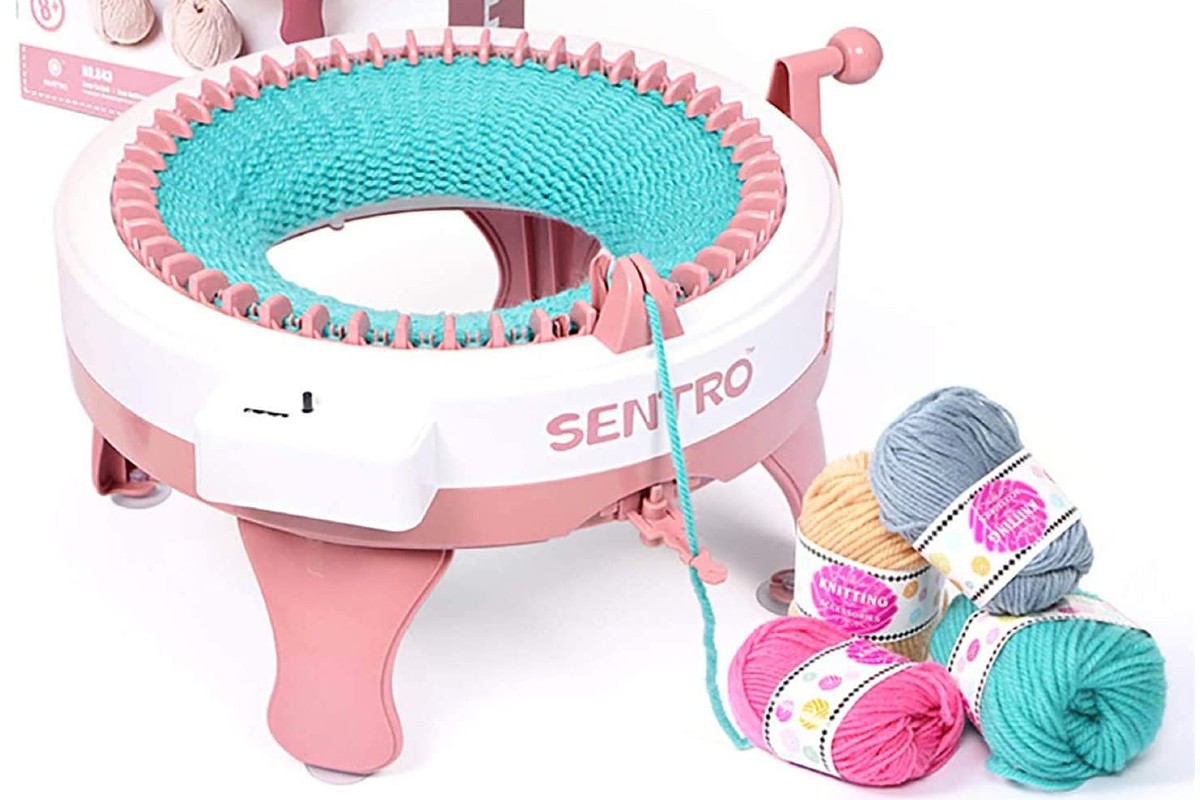
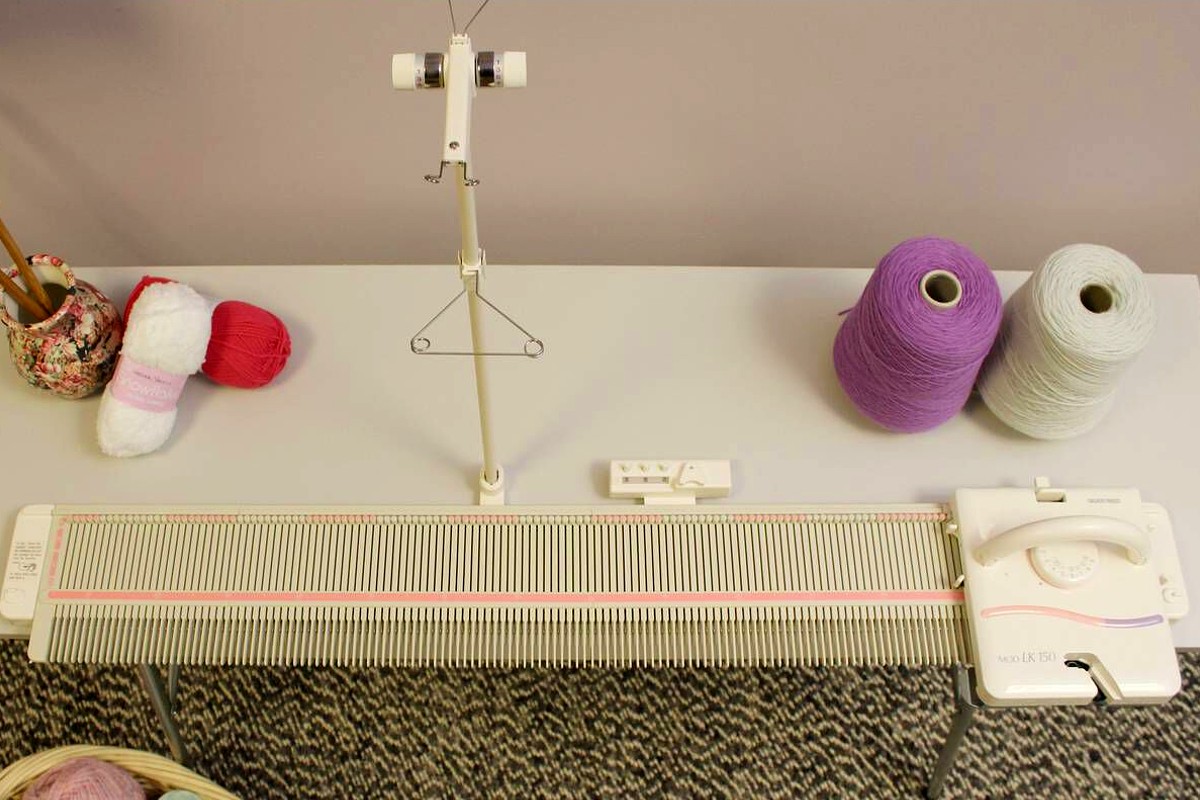
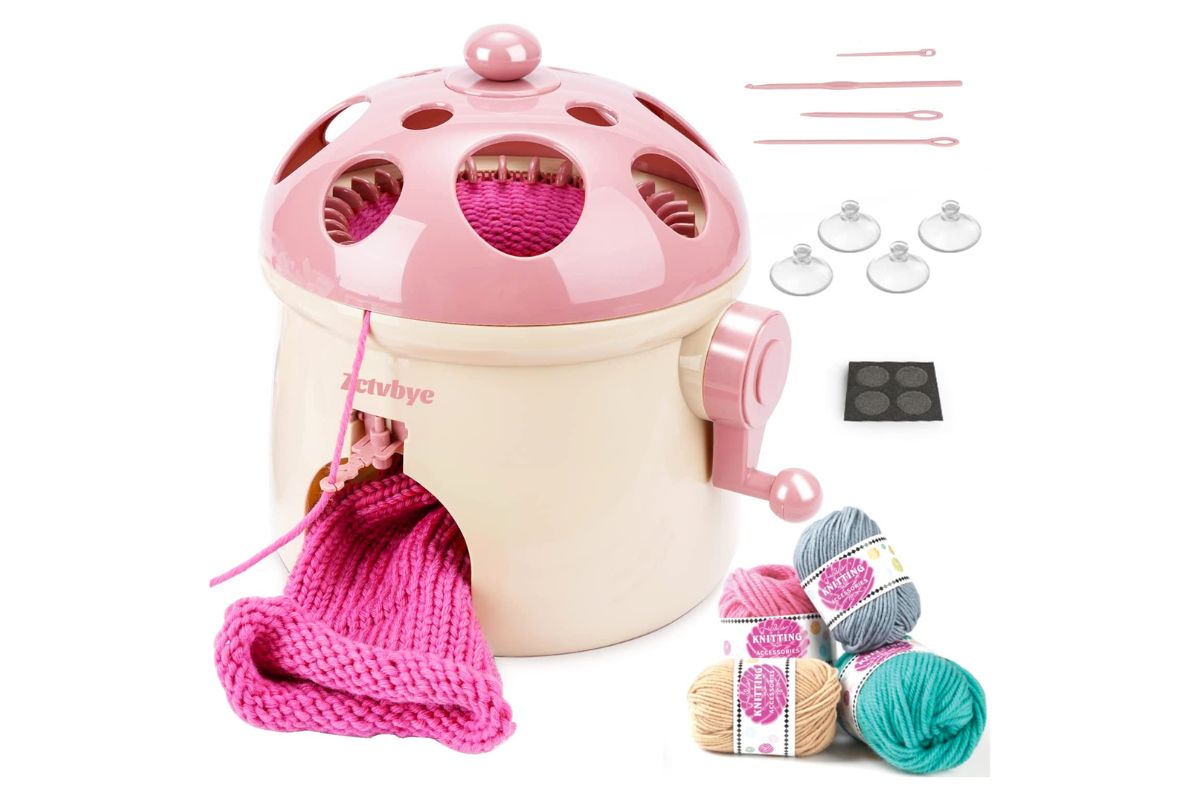
Leave a Reply